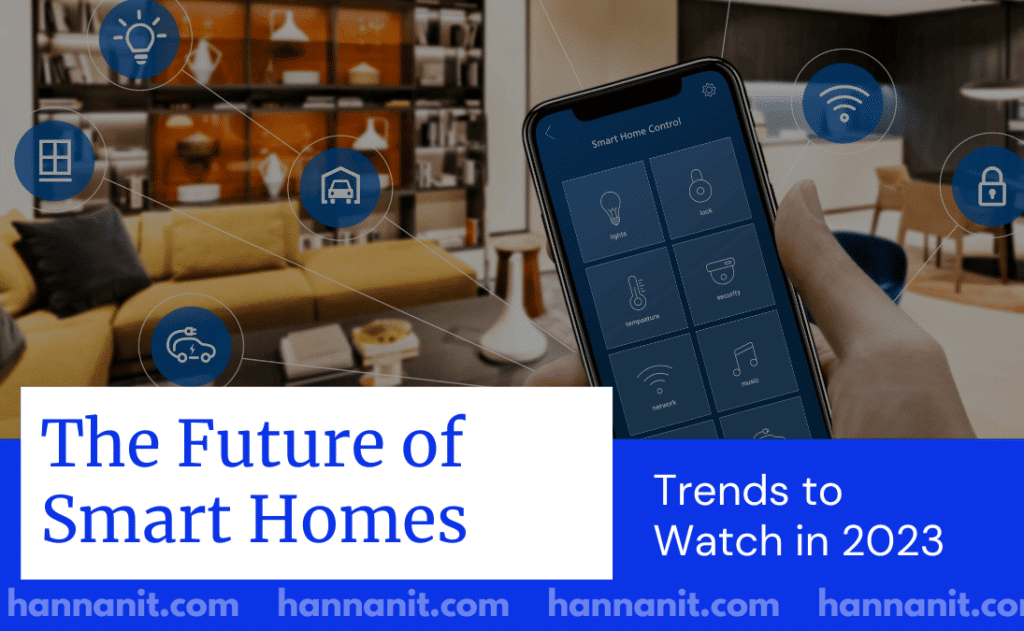Smart homes have become increasingly popular in recent years due to the convenience and comfort they offer. With the continued advancements in technology, the future of smart homes is looking brighter than ever. In 2023, we can expect to see a variety of new trends that will shape the way we interact with our homes. In this article, we will explore the top trends to watch in 2023, including increased integration, artificial intelligence, sustainability, security, and health and wellness.
Future of Smart Homes
Introduction
Smart homes refer to houses that are equipped with various internet-connected devices that allow homeowners to automate and control various functions of their homes remotely. These devices can range from smart thermostats, lighting systems, security cameras, and smart locks. The popularity of smart homes is growing rapidly, with more and more people looking for ways to make their lives more comfortable and convenient
As technology continues to evolve, it’s essential to keep up with the latest trends inFuture of Smart Homes to ensure that you are getting the most out of your devices. In 2023, we can expect to see significant advancements in smart home technology that will shape the way we interact with our homes.
1. Increased Integration
One of the most significant trends that we can expect to see in smart homes in 2023 is increased integration between different devices and platforms. This integration will allow homeowners to control multiple devices and functions using a single app or interface, improving the overall user experience.
For example, in the future, you could use a single app to control your smart lighting, thermostat, and security cameras. This integration will make it easier to manage your home and reduce the time and effort required to do so.
The importance of compatibility and ease of use cannot be overstated when it comes to smart home devices. In 2023, we can expect to see increased compatibility between different devices, making it easier to add new devices to your smart home system.
2. Artificial Intelligence
Artificial intelligence (AI) will play a more significant role in smart homes in 2023. AI algorithms will be used to automate tasks, learn your preferences, and improve the overall efficiency of your home automation.
For example, smart home devices could learn your daily routine and automatically adjust the temperature, lighting, and music based on your preferences. AI-powered security systems could also analyze patterns and identify potential threats before they occur.
While AI will bring significant benefits to smart homes, there are also potential concerns and challenges to consider. Privacy and security concerns will be more prevalent as more devices become connected to the internet. It’s important to ensure that your devices are secure and that you understand the data that is being collected and how it is being used.
3. Sustainability
In 2023, we can expect to see smart homes become more sustainable and eco-friendly. Energy consumption is a significant concern for many homeowners, and smart home technology can help reduce energy usage and costs.
For example, smart thermostats can learn your habits and automatically adjust the temperature to save energy when you’re not at home. Smart lighting systems can also reduce energy usage by turning off lights when a room is empty.
There will also be an increased focus on sustainable smart home products and systems. Homeowners will have access to more eco-friendly devices and systems that can help them reduce their carbon footprint.
4. Security
Smart home security will be more important than ever in 2023. As more devices become connected to the internet, there is an increased risk of cyber-attacks and privacy breaches.
Smart home security systems will become more advanced, with features such as facial recognition, biometric authentication, and real-time monitoring. These security systems will also be more integrated, making it easier to manage and monitor your home’s security from a single interface.
However, with increased security comes increased complexity. It’s essential to ensure that your security systems are set up correctly and that you are using strong passwords and other security measures to protect your devices and data.
5. Health and Wellness
In 2023, we can expect to see smart homes incorporate more health and wellness features. These features will allow homeowners to monitor and improve their physical and mental health from the comfort of their own homes.
For example, smart beds could monitor your sleep patterns and adjust the firmness and position to improve your sleep quality. Smart mirrors could analyze your skin and provide personalized skincare recommendations.
Smart homes could also incorporate mental health features, such as meditation and relaxation programs. These features could help individuals reduce stress and improve their overall well-being.
6. Interoperability
In 2023, we can expect to see more smart home devices become interoperable, meaning they can work seamlessly with other devices from different brands. This will make it easier for homeowners to mix and match devices from various manufacturers, creating a truly customized smart home experience. Interoperability can improve the overall user experience by allowing different devices to communicate with each other and share data, which can lead to more efficient automation and better control over your home.
7. Personalization
Personalization is a crucial trend that we can expect to see in smart homes in 2023. Smart home devices will become more intelligent, using AI algorithms to learn your habits and preferences. This will allow devices to adapt to your needs and provide personalized recommendations. For example, a smart thermostat could learn your daily routine and automatically adjust the temperature to your preferred setting when you arrive home. Personalization can improve the user experience, making smart homes feel more like a personal assistant rather than a series of disconnected devices.
8. Voice Control
Voice control is already a popular feature in many smart homes, and in 2023, we can expect to see more devices become voice-controlled. This feature will allow homeowners to control their devices hands-free, improving the overall user experience. With voice control, you can adjust your lighting, temperature, or music without having to physically interact with your smart home devices. Voice control can also make smart homes more accessible to people with disabilities, allowing them to control their devices more easily.
9. Augmented Reality
Augmented reality (AR) is another trend that we can expect to see in smart homes in 2023. AR can be used to provide virtual tours of your home or to show you how a new piece of furniture will look in your space before you buy it. AR can also be used to provide visual instructions on how to set up and use your smart home devices. This can improve the user experience by providing a more interactive and immersive way to interact with your smart home.
10. Remote Work
With more people working from home, smart homes will become more important than ever in 2023. Smart home devices can be used to create a more comfortable and productive work environment, allowing homeowners to adjust their lighting, temperature, and other factors to optimize their workspace. Smart homes can also be used to set up a dedicated workspace or to create a more efficient workflow. With smart home devices, you can easily switch between work and personal mode, allowing you to achieve a better work-life balance.
So as we can see, the future of smart homes is exciting, with many new trends and technologies set to shape the way we interact with our homes. It’s essential to stay informed and up-to-date on the latest developments to ensure that you are getting the most out of your devices. As technology continues to evolve, smart homes will continue to impact our daily lives in significant ways, and we can expect to see even more innovations in the years to come. The integration of these trends into smart homes will create a more personalized and efficient experience for homeowners, leading to a more comfortable and convenient lifestyle.
Conclusion
In conclusion, the future of smart homes is looking brighter than ever. In 2023, we can expect to see increased integration between different devices and platforms, artificial intelligence playing a larger role, a focus on sustainability, improved security measures, and more health and wellness features
It’s essential to stay informed and up-to-date on the latest trends in smart home technology to ensure that you are getting the most out of your devices. As technology continues to evolve, smart homes will continue to impact our daily lives in significant ways.
FAQs
What are smart homes, and how do they work?
Smart homes are houses that are equipped with various internet-connected devices that allow homeowners to automate and control various functions of their homes remotely. These devices can range from smart thermostats, lighting systems, security cameras, and smart locks.
What are the benefits of smart homes?
Smart homes offer a range of benefits, including convenience, comfort, energy efficiency, improved security, and more.
How will artificial intelligence impact smart homes in 2023?
Artificial intelligence (AI) will play a more significant role in smart homes in 2023. AI algorithms will be used to automate tasks, learn your preferences, and improve the overall efficiency of your home automation.
How can smart homes help with sustainability?
Smart homes can help with sustainability by reducing energy usage and costs. For example, smart thermostats can learn your habits and automatically adjust the temperature to save energy when you’re not at home.
How important is smart home security?
Smart home security is essential, as more devices become connected to the internet, there is an increased risk of cyber-attacks and privacy breaches. It’s crucial to ensure that your security systems are set up correctly and that you are using strong passwords and other security measures to protect your devices and data.




Omg I learnt so much from that I was unaware of 😮
Waooooooooo
Amazing
That’s much is happening in the world and we are unware. Thanks for sharing